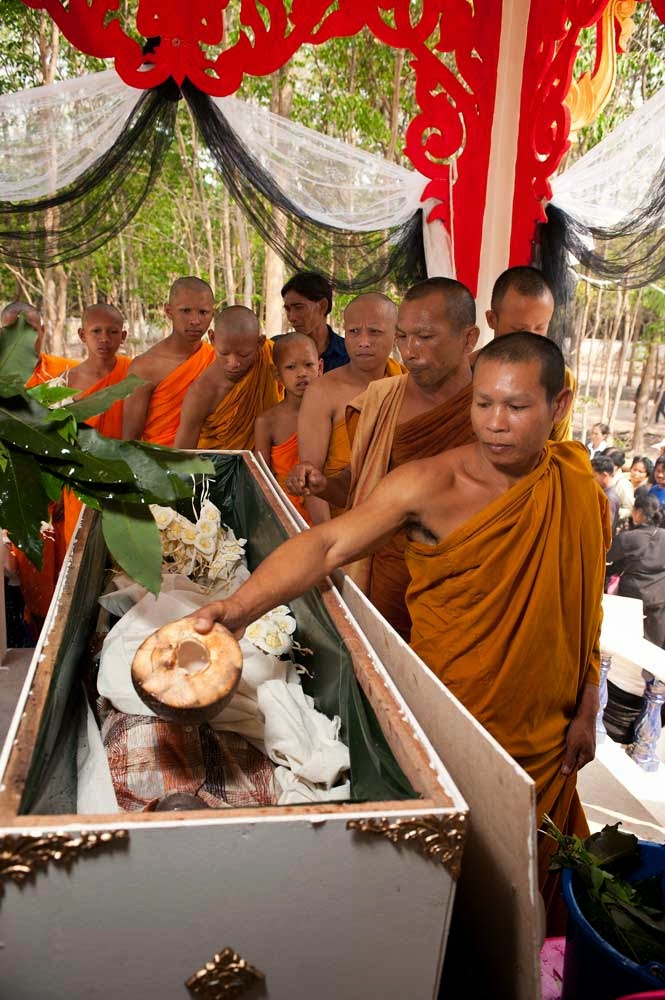 |
| Prepared Green Coconuts |
Funerals here in Isaan, Northeast Thailand, amongst the ethnic Lao people are milestone life events. The Theravada Buddhist funeral ritual is comprised of many rites, traditions, and offerings - all intended to free the spirit of the deceased person, prepare the spirit for the journey to a new world, and help the spirit to come back to a better life upon reincarnation.
The ritual is a combination and adaptation of rites from the Animist, Brahmin (pre-Hindu), and Buddhist belief systems.
 |
| Preparing Green Coconuts for Funeral Ritual |
Off to the side of the cremation furnace, while the Monks and laypeople are participating in merit making rituals in the sala, worship hall, a man or sometimes men prepare green coconuts to pour the water that they contain on the corpse. Using heavy sugar cane knives, the people take three to four slices off of the bottom of the thick fibrous husk of the coconut. This allows the coconuts to sit flat on the ground and ultimately on the concrete floor of the platform to the doors of the furnace.
After the bottom of the coconuts are flattened. several slices ate taken off the top of the coconut to expose the top of the actual nut buried beneath the husk. The point of the knife is then used to open up a small hole from which the water will exit. The prepared coconuts are carried up the side stairway to the furnace platform and placed off to the side of the head of the coffin.
 |
| The Abbott along with Ex-Husband of the Deceased Woman About to Pour Coconut Water |
The senior Monk then pours coconut water over the body starting from the head down to the feet. He is followed by other Monks from the local wat or wats. The Monks who follow the senior Monk share coconuts between themselves to ensure that each is able to pour coconut water on the body.
Part of the contingent of Monks are male members of the immediate family. On the day of cremation, sons, some nephews, grandsons, and some uncles will have their heads and eyebrows shaved to become Monks for the day. The relatives, earlier in the day, had gone through a simplified ordination ritual to be able to participate as Monks to earn merit for themselves and more importantly for the deceased person.
Closely following the Monks are members of the immediate family - each pouring some coconut water on the body. Some family members will gently and lovingly rub the water over face while wishing the spirit good luck on its journey and subsequent rebirth.
 |
| Cleansing the Spirit with Coconut Water |
When there is no longer any coconut water available to pour over the corpse, ordinary water is scooped out of a nearby bucket using a bowl or a glass to pour over the body.
 |
| Pouring Ordinary Water Over the Body |
From my 8 years of exposure to the ethnic Lao culture, I would say that the banana plant, bamboo, sticky rice, and the coconut are essential to Lao Loum society. The pouring of coconut water over the corpse is symbolic of the hope that the spirit will be reborn in a place that is fertile and with sufficient water to grow rice. Since coconut water is enjoyed by many of the Lao Loum people and is recognized for it thirst quenching ability, the pouring also is symbolic of nourishing and refreshing the spirit for its journey.
Pouring of ordinary water also symbolizes the wishes of the people for the spirit to be reborn in a fertile land suitable for rice cultivation.
For the Buddhists, there can be no life without first death. The funeral ritual and the Theravada Buddhist attitude towards death reinforce and affirm the beliefs of impermanence and the opportunity to help the departed in their journey to enlightenment.


















































